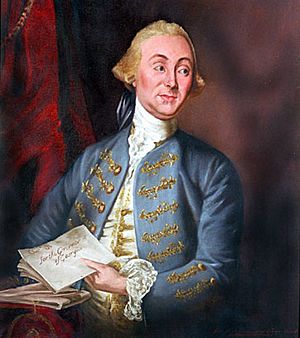James Wright (governor) facts for kids
Quick facts for kids
James Wright
|
|
|---|---|

Portrait by Andrea Soldi
|
|
| 7th Governor of Carolina and Georgia | |
| In office 1760–1776 |
|
| Monarch | George III |
| Preceded by | Henry Ellis |
| Succeeded by | Archibald Campbell |
| Personal details | |
| Born | 8 May 1716 London, England |
| Died | 20 November 1785 (aged 69) London, England |
| Spouse | Sarah Maidman (died 1774) |
| Children | 9 |
| Relatives | Robert Wright (father) Sir Robert Wright (grandfather) |
| Profession | Lawyer, jurist, governor |
James Wright (born May 8, 1716 – died November 20, 1785) was a lawyer and judge in the American colonies. He was the very last British Royal Governor of the Province of Georgia. He was also the only Royal Governor of the Thirteen Colonies who managed to get his colony back under British control during the American Revolutionary War.
Contents
Life Story
James Wright was born in London, England. His father, Robert Wright Jr., was a judge in South Carolina.
In 1730, James's father moved to the Province of South Carolina and became its Chief Justice. James soon followed and started working as a lawyer in Charleston. He also began buying large areas of land for plantations. In 1747, he became the main lawyer for the colony, called the colonial attorney-general.
In 1757, Wright went back to London. In May 1760, he was chosen to be the Lieutenant Governor of Georgia, working under Henry Ellis. He moved to Savannah, Georgia. When Governor Ellis left, James Wright became the Governor in November 1760. He was the third Royal Governor of Georgia and was quite popular. He sold his lands in South Carolina and bought new lands in Georgia. He also moved his money and business dealings there.
Wright worked with the Native Americans and the British King to open up new lands for settlers. This helped Georgia grow and become more successful.
Facing Challenges
His first big problem came with the Stamp Act of 1765. This law made colonists pay a special tax on printed materials. Many colonists were very angry about it. Groups like the Sons of Liberty tried to stop the tax. But Georgia was the only colony that actually used the tax stamps.
In 1768, Wright helped create a new settlement called Wrightsboro, Georgia. It was a 12,000-acre area for Quakers who had been forced to leave North Carolina.
As the American Revolution began, Georgia remained the most loyal colony to Britain. This was partly because many people in Georgia had recently moved from Great Britain and still had family ties there. Governor Wright's good leadership also helped keep the colony loyal. Georgia did not even send representatives to the First Continental Congress in 1774. That same year, his wife, Sarah, passed away.
Revolution and Escape
By 1775, the idea of revolution had spread to Georgia. Wright tried to stop it by closing the local assembly. But a new revolutionary group met in Savannah that summer. They chose people to represent Georgia at the Second Continental Congress.
In early 1776, British ships arrived. Rebel forces entered Wright's home and took him prisoner for a short time. But on February 11, 1776, Wright managed to escape. He got away through Bonaventure Plantation with help from two friends, Colonel John Mullryne and Josiah Tattnall. He reached the safety of a British ship, HMS Scarborough, and sent a letter to his council. However, the council did not answer him.
Wright tried to negotiate with the rebels and even traded with them to get supplies for his troops. But the disagreements grew worse. When his attempt to take Savannah back with naval forces failed, he returned to England.
Regaining Control
By 1778, Governor Wright convinced the British government to give him enough soldiers to try and take Savannah again. After some quick battles, he regained control of Savannah on December 29, 1778. He wasn't fully in charge of the whole state, but he did bring large parts of Georgia back under British rule. This made Georgia the only one of the Thirteen Colonies that the British managed to get back after being forced out.
Wright successfully defended Savannah against several attacks by American and French forces. When the war was finally lost, he left Georgia on July 11, 1782, and went back to England.
The revolutionary governments in South Carolina and Georgia took away all of Wright's many properties. He died in London and is buried in Westminster Abbey.
Wright's Family
James Wright and his wife, Sarah Maidman, had nine children. Here are some of them:
- Sir James Wright (1747–1816), who became the 2nd Baronet.
- Sarah (born 1744), who moved to Jamaica and then to England.
- Alexander (born 1751), who was loyal to Britain and lost his lands in America. He moved to Jamaica.
- Charles
- Ann (born 1749), who married British Admiral James Wallace.
- Elizabeth
- Charlotte
- Mary (1742–1763)
- Isabella, who married General Thomas Barrow in 1757.
Legacy
Wright Square in Savannah, Georgia, is named in his honor.
Images for kids



